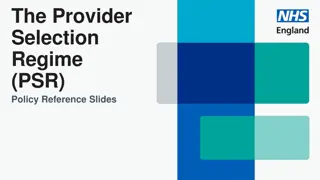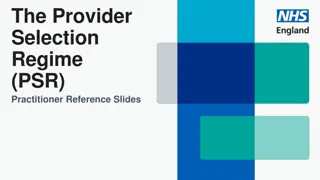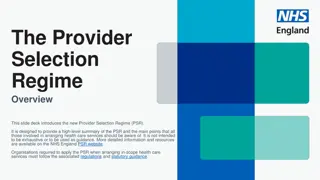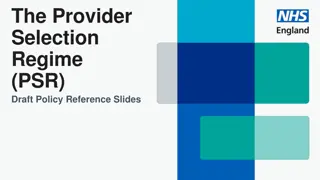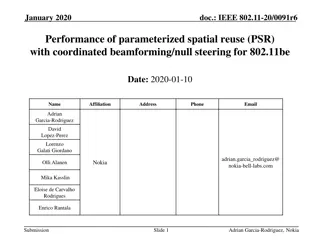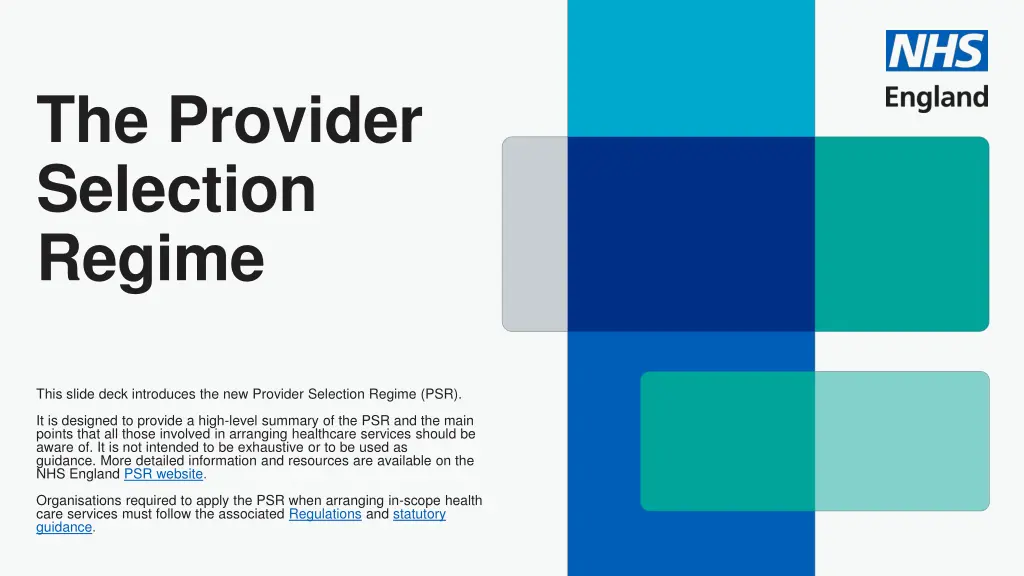
Provider Selection Regime Overview in England
Explore the Provider Selection Regime (PSR) introduced under the Health and Care Act 2022 for procuring healthcare services in England. Learn about key points, regulations, and the aim to improve service quality and efficiency. Access resources for implementing the PSR effectively.
Download Presentation

Please find below an Image/Link to download the presentation.
The content on the website is provided AS IS for your information and personal use only. It may not be sold, licensed, or shared on other websites without obtaining consent from the author. If you encounter any issues during the download, it is possible that the publisher has removed the file from their server.
You are allowed to download the files provided on this website for personal or commercial use, subject to the condition that they are used lawfully. All files are the property of their respective owners.
The content on the website is provided AS IS for your information and personal use only. It may not be sold, licensed, or shared on other websites without obtaining consent from the author.
E N D
Presentation Transcript
The Provider Selection Regime This slide deck introduces the new Provider Selection Regime (PSR). It is designed to provide a high-level summary of the PSR and the main points that all those involved in arranging healthcare services should be aware of. It is not intended to be exhaustive or to be used as guidance. More detailed information and resources are available on the NHS England PSR website. Organisations required to apply the PSR when arranging in-scope health care services must follow the associated Regulations and statutory guidance.
Overview The Provider Selection Regime (PSR) is a set of rules that relevant authorities must follow when procuring healthcare services in England. The PSR was created under the Health and Care Act 2022 as part of wider measures to promote greater integration of health and care services. The PSR came into effect on 1 January 2024. The procurement of healthcare services is not in scope of the Procurement Act 2023. The relevant authorities required to follow the PSR when procuring healthcare services are: NHS England integrated care boards NHS trusts and NHS foundation trusts local authorities or combined authorities These slides are intended to support relevant authorities with their application of the PSR. They are not exhaustive and should not be used in lieu of the PSR statutory guidance and the Health Care Services (Provider Selection Regime) Regulations 2023 (the Regulations), which relevant authorities must follow. A PSR toolkit supports relevant authorities to apply the regime. These resources can be accessed via the NHS England PSR webpage. 2
Context for the legislation The Health and Care Act 2022 (the 2022 Act) codified the move towards more integrated working across the health and care system, so that decisions taken by commissioners and providers are in the best interest of all patients and service users. As part of the necessary reforms to achieve its aim, the 2022 Act introduced a new regime for selecting providers of healthcare services in England: the Provider Selection Regime (the PSR). The Health Care Services (Provider Selection Regime) Regulations 2023 set out the detail of the PSR. Relevant authorities must also have regard to the associated PSR statutory guidance. The PSR came into effect on 1 January 2024 and replaced: Public Contracts Regulations 2015 (PCR), when arranging healthcare services* National Health Service (Procurement, Patient Choice and Competition) Regulations 2013 * The Procurement Act 2023 replaced the PCR on 24 February 2025. Procurements arranged under the PSR remain out of scope of the Procurement Act 2023. 3
Key points of the PSR In line with the provisions in the Health and Care Act 2022, the PSR: The PSR requires organisations to: act transparently, fairly and proportionately act with a view to: provides a flexible and proportionate process for deciding who should provide healthcare services securing the needs of the people who use the services enables collaboration across systems improving the quality of the services ensures that all decisions are made in the best interest of all patients and service users improving the efficiency of the services including through integrated service delivery 4
Scope of the PSR legislation A service is in scope when a relevant authority is commissioning or subcontracting a service that: is provided as part of the health service, whether NHS or public health consists of the provision of healthcare to individuals or groups of individuals falls within one or more of the specified CPV codes, and at least the general health services code. In scope are: healthcare services arranged by the NHS, for example hospital, community, mental health, primary care services public health services arranged by local authorities, for example substance use, sexual and reproductive health and health visitors Out of scope are: goods,for example medicines, medical equipment social care services non-health care services or health- adjacent services, for example capital works, business consultancy 5
Overview of the provider selection processes Relevant authorities can follow the below provider selection processes to award contracts for healthcare services: The competitive process The most suitable provider process Direct award process A B C Wherepeople have a choice of providers, and the number of providers is not restricted by the relevant authority. Where there is an existing provider for the services and that existing provider is satisfying the original contract and will likely satisfy the proposed new contract, and the services are not changing considerably. Where there is an existing provider for the services and that provider is the only capable provider. Where the relevant authority wishes to run a competitive exercise, or it wishes to conclude a framework agreement. Wherethe relevant authority is able to identify the most suitable provider without running a competitive process. 6
The basic selection criteria and key criteria The relevant authority must assess providers against the basic selection criteria and is expected not to award a contract to a provider that does not meet these. When following direct award process C, the most suitable provider process or the competitive process, the relevant authority must also take into account the key criteria. It is for the relevant authority to determine the importance it will give to each of the key criteria in selecting the provider to deliver the particular contract. Quality and innovation Basic selection criteria The provider s ability to pursue a particular activity Value Key criteria Integration, collaboration and service sustainability Economic and financial standing Improving access, reducing health inequalities and facilitating choice Technical and professional ability Social value 7
Transparency The PSR provides for greater flexibility in deciding how best to arrange local healthcare services and allows relevant authorities to award contracts without using a competitive process, where appropriate. Other checks and balances are therefore in place to ensure that the PSR is complied with and that the flexibilities are used appropriately and in the best interest of patients and service users. These include: specific transparency requirements: intention to use a process (most suitable provider process) invitation of bids for the competitive process intention to award notices (most suitable provider process, competitive and direct award C) award notices (all processes) modification notices notification of other decisions during a PSR process (for example, abandoning a process, urgent circumstances) specific record keeping requirements 8
Reviewing decisions during the standstill period The standstill period applies where relevant authorities followed direct award process C, the most suitable provider process or the competitive process. The standstill period does not apply to direct award processes A and B. During the standstill period: providers can bring representations against provider selection decisions relevant authorities have to review representations and to make a further decision about whether to proceed with the award of the contract, return to an earlier step in the process or abandon the process where a provider remains unsatisfied that a relevant authority has followed processes or met the requirements of the PSR when awarding a contract, it may seek a review by the Independent Patient Choice and Procurement Panel the panel may accept representations and offer advice to the relevant authority; the relevant authority will take a further decision based on that advice about whether to proceed with the award of the contract, return to an earlier step in the process or abandon the process 9
Transitional provisions The PSR came into effect on 1 January 2024. Where relevant authorities started a contract award process before 1 January 2024 using the Public Contracts Regulations 2015 (PCR), then they must conclude that process under the PCR rules. Where relevant authorities started a contract award process on or after 1 January 2024, then they must apply the PSR even where awarding a contract based on a framework agreement that was established under the PCR rules. Any contract modifications after the 1 January 2024 must be carried out using the PSR, even if the original contract was awarded under the PCR rules. 10
Helpful materials NHS England s PSR statutory guidance sets out what relevant authorities must do to comply with the PSR legislation. Relevant authorities must have regard to this statutory guidance. NHS England has also published a range of tools to help relevant authorities prepare for implementation. These include: process maps (one for each decision-making process) Find A Tender Service (FTS) guide a series of slide decks to provide an overview for commissioners and an in-depth look at the PSR for practitioners These are available on the PSR toolkit products webpage. FAQs are also provided. 11
Questions? Thank You psr.development@nhs.net @nhsengland company/nhsengland england.nhs.uk 12

